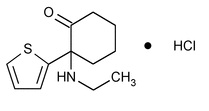Tiletamine Hydrochloride
(tye let' a meen hye'' droe klor' ide).
Cyclohexanone, 2-(ethylamino)-2-(2-thienyl)-.
2-(Ethylamino)-2-(2-thienyl)cyclohexanone hydrochloride
» Tiletamine Hydrochloride contains not less than 97.0 percent and not more than 103.0 percent of C12H17NOS·HCl.
Packaging and storage—
Preserve in tight containers.
Labeling—
Label it to indicate that it is for veterinary use only. Where it is intended for use in preparing injectable dosage forms, the label states that it is sterile or must be subjected to further processing during the preparation of injectable dosage forms.
Clarity of solution—
Dissolve 1.0 g of it in 10 mL of water: the solution is clear.
Identification—
B:
Ultraviolet Absorption  197U
197U —
—
Solution:
0.3 mg per mL.
Medium:
0.1 N hydrochloric acid.
Absorptivities at 234 nm do not differ by more than 3.0%.
C:
It meets the requirements of the tests for Chloride  191
191 .
.
Melting range  741
741 :
between 190
:
between 190 and 195
and 195 , within a 2
, within a 2 range.
range.
Bacterial endotoxins  85
85 —
Where the label states that Tiletamine Hydrochloride is sterile or must be subjected to further processing during the preparation of injectable dosage forms, it contains not more than 0.07 USP Endotoxin Unit per mg of tiletamine.
—
Where the label states that Tiletamine Hydrochloride is sterile or must be subjected to further processing during the preparation of injectable dosage forms, it contains not more than 0.07 USP Endotoxin Unit per mg of tiletamine.
Sterility  71
71 —
Where the label states that Tiletamine Hydrochloride is sterile, it meets the requirements when tested as directed for Membrane Filtration under Test for Sterility of the Product to be Examined.
—
Where the label states that Tiletamine Hydrochloride is sterile, it meets the requirements when tested as directed for Membrane Filtration under Test for Sterility of the Product to be Examined.
pH  791
791 :
between 3.0 and 5.0, in a solution (1 in 10).
:
between 3.0 and 5.0, in a solution (1 in 10).
Water, Method I  921
921 :
not more than 1.0%.
:
not more than 1.0%.
Residue on ignition  281
281 :
not more than 0.5%.
:
not more than 0.5%.
Heavy metals, Method II  231
231 :
0.002%.
:
0.002%.
Chromatographic purity—
Prepare a test solution of Tiletamine Hydrochloride in methanol containing 50.0 mg per mL. Prepare a Standard solution in methanol containing 1.0 mg of USP Tiletamine Hydrochloride RS per mL. Prepare a thin-layer chromatographic plate (see Chromatography  621
621 ) coated with a 0.25-mm layer of chromatographic silica gel mixture as follows. Prewash the plate by developing it in a mixture of methanol and ether (8:2) to the top of the plate, and allow the plate to dry. Separately apply 5 µL of the test solution and the Standard solution to the plate, and develop the chromatogram until the solvent front has moved about three-fourths of the length of the plate. Remove the plate from the chamber, mark the solvent front, allow the plate to air-dry, and examine under short- and long-wavelength UV light: no individual secondary spot observed in the chromatogram obtained from the test solution is greater in size or intensity than the principal spot observed in the chromatogram obtained from the Standard solution, corresponding to 2%, and the total of any such spots observed does not exceed 3%.
) coated with a 0.25-mm layer of chromatographic silica gel mixture as follows. Prewash the plate by developing it in a mixture of methanol and ether (8:2) to the top of the plate, and allow the plate to dry. Separately apply 5 µL of the test solution and the Standard solution to the plate, and develop the chromatogram until the solvent front has moved about three-fourths of the length of the plate. Remove the plate from the chamber, mark the solvent front, allow the plate to air-dry, and examine under short- and long-wavelength UV light: no individual secondary spot observed in the chromatogram obtained from the test solution is greater in size or intensity than the principal spot observed in the chromatogram obtained from the Standard solution, corresponding to 2%, and the total of any such spots observed does not exceed 3%.
Chloride content—
Transfer about 250 mg of it, accurately weighed, to a conical flask, add 5 mL of water, 5 mL of glacial acetic acid, and 50 mL of methanol, and swirl to dissolve. Add 1 drop of eosin Y TS, and titrate with 0.1 N silver nitrate VS to the endpoint when the granular precipitate first turns to a permanent pink color. Each mL of 0.1 N silver nitrate is equivalent to 3.545 mg of chloride: between 13.24% and 14.06% is found.
Assay—
Transfer about 300 mg of Tiletamine Hydrochloride, accurately weighed, to a conical flask, add 70 mL of glacial acetic acid and 10 mL of mercuric acetate TS, and swirl to dissolve. Add 2 drops of crystal violet TS, and titrate with 0.1 N perchloric acid VS to a blue-green endpoint. Perform a blank determination, and make any necessary correction. Each mL of 0.1 N perchloric acid is equivalent to 25.98 mg of C12H17NOS·HCl.
Auxiliary Information—
Please check for your question in the FAQs before contacting USP.
| Topic/Question | Contact | Expert Committee |
|---|---|---|
| Monograph | Morgan Puderbaugh, B.S.
Associate Scientific Liaison 1-301-998-6833 |
(SM32010) Monographs - Small Molecules 3 |
| Reference Standards | RS Technical Services 1-301-816-8129 rstech@usp.org |
|
| Radhakrishna S Tirumalai, Ph.D.
Principal Scientific Liaison 1-301-816-8339 |
(GCM2010) General Chapters - Microbiology | |
| Radhakrishna S Tirumalai, Ph.D.
Principal Scientific Liaison 1-301-816-8339 |
(GCM2010) General Chapters - Microbiology |
USP35–NF30 Page 4867

